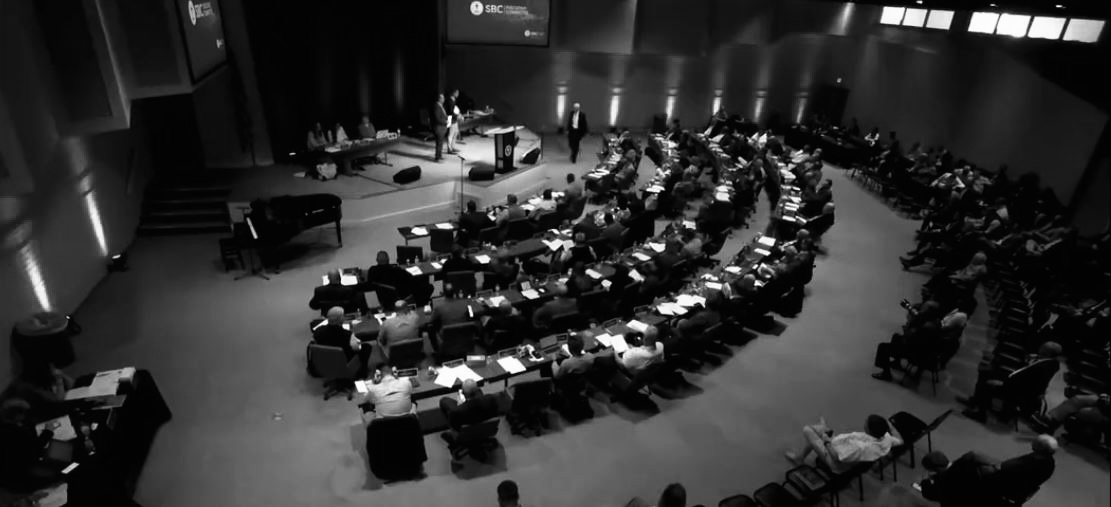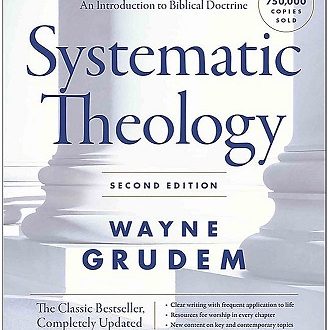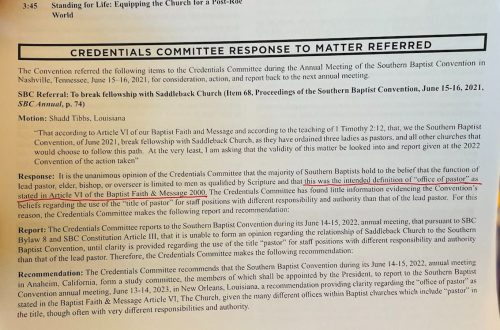I have seen a variety of responses to the news yesterday that the SBC has found Saddleback Church to be out of step with “the Convention’s adopted statement of faith” and now no longer recognizes them as a “cooperating” church (Art. 3, SBC Constitution). As many of you know, the presenting issue is Saddleback’s recognition of a variety of female pastors, including one of their new lead teaching pastors. Having female pastors contradicts our statement of faith, The Baptist Faith & Message (BF&M), which says, “While both men and women are gifted for service in the church, the office of pastor is limited to men as qualified by Scripture.”
As you can imagine, many of the public responses have been negative. On social media, some of the commentary has been incendiary and dismissive and therefore not worthy of serious engagement. Other critics simply do not like what Southern Baptists believe. Still, there are two objections that I thought it might be worth the effort to answer.
The first objection appears in a social media thread that Rick Warren himself “liked” on Twitter. The author shares a series of quotations from around the time that the BF&M was adopted in 2000 and observes how many SBC leaders at the time said that the BF&M would never be used to “coerce” Baptist churches. He quotes from one 2000 Baptist Press article which has compelling comments from both Albert Mohler and Adrian Rogers:
“We don’t have the right, the authority or the power to limit anybody,” Rogers noted. “We would resist that. What we are stating is what we believe mainstream Baptists believe. … It is not a creed. It is a statement of what most of us believe.”
Other media questions focused on the new BFM’s stance against women serving as senior pastors.
“We would never presume to tell another church whom they may call as a pastor or tell another person whether or not they may serve as pastor,” Mohler said. “We’re not trying to force our beliefs on someone else.”
The author highlights these remarks and others like them to show that the BF&M was never meant to be “binding on individual SBC congregations” (source). He concludes from this that the BF&M was never intended to be a “parameter for cooperation” (source). Both of these observations are wrong and represent a serious misunderstanding of our polity.
Right now in 2023, I heartily affirm what both Adrian Rogers and Albert Mohler said 23 years ago. The SBC does not have the right or authority to tell any church whom they may call as pastor. The SBC has zero authority to tell a church what they can or cannot do or what they must or must not believe. How a church governs itself or chooses its pastors is not what this dispute is about.
This discussion is about whether the SBC has a right to recognize which churches are in friendly cooperation with the convention. Our polity says that the SBC does have that right. Furthermore, the SBC Constitution defines some parameters for determining which churches are in friendly cooperation. The Constitution says it this way:
The Convention will only deem a church to be in friendly cooperation with the Convention, and sympathetic with its purposes and work (i.e., a “cooperating” church as that term is used in the Convention’s governing documents) which… Has a faith and practice which closely identifies with the Convention’s adopted statement of faith…
To be in friendly cooperation, a church must have a faith and practice that is in step with the BF&M. Contradicting what the BF&M says about female pastors is by definition not “closely identifying” with the BF&M. Indeed, it’s a direct contradiction of the BF&M, and the SBC is both constitutionally and morally right to deem a church like Saddleback as no longer in “friendly cooperation.”
The second objection comes from Adam Greenway and reiterates the argument he made on the floor of the convention last year in Anaheim. He believes the Executive Committee’s action is wrong because Article 3 of the SBC Constitution only has three parameters for deeming a church to be in friendly cooperation. He writes,
Article III of the SBC Constitution contains the elastic clause of “closely identifying” w/the BFM as the requirement for cooperating churches. But that same article specifically enumerates three and only three clear disqualifications: affirming homosexuality, racism, abuse.
These three disqualifying conditions provide an objective basis for determining SBC church cooperation. Anything beyond these three moves are simply subjective judgment calls. By taking the action they did, the SBCEC became a magisterium, authoritatively interpreting the BFM.
To me, this is an astonishing claim. If this reading of Article 3 were correct, those who deny the substitutionary atonement of Christ could possibly be deemed in friendly cooperation with the SBC. Those who deny the Trinity could possibly be deemed in friendly cooperation with the SBC. Those who deny the virgin birth of Christ and the inerrancy of scripture could possibly be deemed in friendly cooperation. After all, if there are only “three disqualifications” as Greenway argues, then the sky is the limit as to what a church may deny from the BF&M and still be deemed in “friendly cooperation.”
This is not a plausible reading of Article 3 of the SBC Constitution. There is no way that the authors of Article 3 intended “closely identifies with” to mean “feel free to deny any article in the BF&M except for the parts about homosexuality, racism, and abuse.” Look carefully at the language of Article 3. It points to homosexuality, racism, and abuse “by way of example” of the kinds of contradictions that could put a church at odds with the BF&M, not as the only three things in the BF&M that matter. The language of Article 3 doesn’t require churches to adopt the BF&M as their official creedal statement. It simply requires that their faith and practice closely identify with the BF&M, which at the very least means not to contradict it.
Saddleback is clearly contradicting the BF&M’s prohibition on female pastors, and that is why this has become an issue. Saddleback had already acted contrary to our doctrine in 2021 when they ordained three female pastors. After that in 2022, Saddleback called a husband and wife team to be lead teaching pastors of the church. Former pastor Rick Warren declared his support for the ordination of female pastors on the floor of the SBC annual meeting last June. New Saddleback pastor Andy Wood told the Associated Press last year that he intends to expand the number of women serving in pastoral roles. All of this seems to indicate that Saddleback has no intention of “closely identifying with” what the BF&M says about female pastors.
As a Baptist church, Saddleback is of course free to appoint whomever they wish as pastor. The SBC has no control over that and would not presume to assume control over who they call as pastor. But the SBC does have the right to determine what the parameters of our cooperation are, and we have done that in the BF&M. The Executive Committee has correctly recognized that Saddleback is outside those parameters. Saddleback will have a chance to appeal that decision to the messengers next June at our annual meeting if they so choose.
I wish that we weren’t having this conflict, and I wish that Saddleback hadn’t forced the issue. I would have preferred for them to align their faith and practice with what the Bible teaches about pastors. But they have chosen not to do that. Indeed, they have chosen to double down on their departure from what the BF&M says. Their departure is over what most of us believe to be a secondary issue, therefore it doesn’t mean that they have ceased to be a Christian church. It just means that they are no longer in friendly cooperation.
The Baptist Faith & Message clearly affirms what the Bible teaches—that only qualified men may serve in the office of pastor (1 Tim. 2:12; 3:2). The only thing that remains is for Southern Baptists to make clear what they think about this when they gather in New Orleans next summer. I suspect they will make themselves very clear should the need arise, and they will do so in a way that affirms our statement of faith. At the very least, that is what I am praying for as we look forward to our meeting in June.






